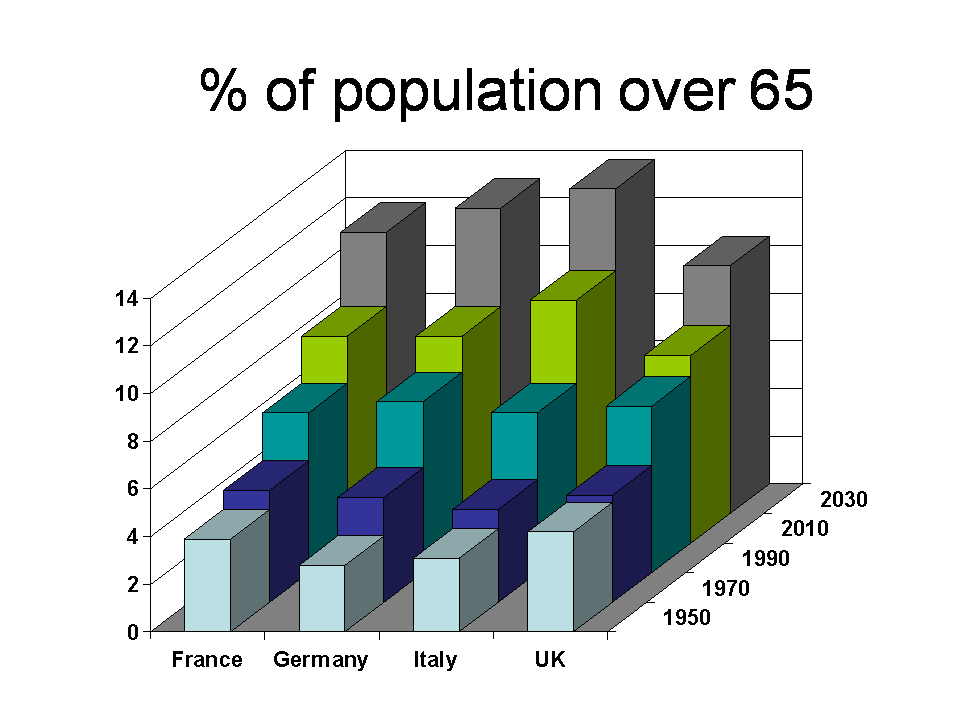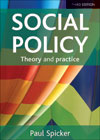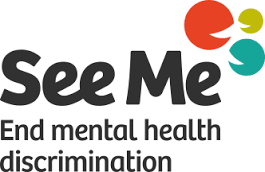 There are increasing numbers of elderly
people throughout the developed world. Many have no problems, but there
is a risk of increasing dependency. The main reasons for dependency are:
There are increasing numbers of elderly
people throughout the developed world. Many have no problems, but there
is a risk of increasing dependency. The main reasons for dependency are:An introduction to Social Policy

The idea of need refers to
Bradshaw identifies four main categories of need:
External links (PDF): Jonathan Bradshaw on Social Policy; Paul Spicker - Needs as claims
The idea of 'risk' is used to mean different things:
People are at risk if there is a possibility or prospect that something might happen. They are vulnerable if, when it happens, they do not have the resources or protection to avoid harm. People can take on high risk without being vulnerable (as some entrepreneurs do); they can be vulnerable even if their risks are relatively low. Social policy is more usually concerned with protecting people who are vulnerable, than it is with risk as such.
People are excluded when they are not part of the networks which support most people in ordinary life - networks of family, friends, community and employment. Among many others, poor people, ex-prisoners, homeless people, people with AIDS, people with learning disabilities or psychiatric patients might all be said to be at risk of exclusion. This is a very broad concept: it includes not only deprivation, but problems of social relationships, including stigma, social isolation and failures in social protection .
In practice, the idea of exclusion is mainly used in three contexts. The first is financial: exclusion is identified with poverty, and its effect on a person's ability to participate in normal activities. The second is exclusion from the labour market: exclusion is strongly identified with long-term unemployment (though there is some research evidence to question whether long-term unemployed people are really excluded). Third, there is exclusion in its social sense, which identifies exclusion partly with alienation from social networks, and partly with the circumstances of stigmatised groups.
The idea of social exclusion comes from France, where it was the basis for a policy of 'insertion' or social inclusion, combining benefits with plans and agreements to integrate people into society. This policy has been widely imitated, and the idea of exclusion has become one of the main concepts in the European Union.
Further material: Poverty
 There are increasing numbers of elderly
people throughout the developed world. Many have no problems, but there
is a risk of increasing dependency. The main reasons for dependency are:
There are increasing numbers of elderly
people throughout the developed world. Many have no problems, but there
is a risk of increasing dependency. The main reasons for dependency are:
Other problems may include
In general, the older a person is, the more likely these problems are to occur. However, it does not follow that an ageing population has more ill-health than a younger population. Some commentators suppose an ‘expansion of morbidity’, suggesting that people are ill for longer; but there there is a contradictory view, the ‘compression of morbidity’, which says that people are healthier for longer. The evidence is not certain for either. [2]
Children have the same human needs as everyone else - for example, for material security, social contact, and personal development. But they also have particular needs related to their development. Mia Kellmer Pringle identifies these as needs for:
In large part, children's needs are seen as dependent on their parents. The United Nations Declaration of the Rights of the Child declares:
'The child, for the full and harmonious development of his personality, needs love and understanding. He shall, wherever possible, grow up in the care and under the responsibility of his parents, and in any case in an atmosphere of affection and of moral and material security. ' [4]
The needs of children are treated as a social issue when families fail to meet them - either because the family is unable to make provision (education and child poverty) or because the family itself is a source of problems (neglect and abuse).
 'Mental
illness' is a broad term covering a range of
conditions. The most important are
'Mental
illness' is a broad term covering a range of
conditions. The most important are
Mental illness can be seen as primarily a medical or physiological condition; however, because it is identified through the behaviour of the mentally ill person, it can also be seen as social. 'Anti-psychiatrists' have argued that conditions like schizophrenia and depression are best understood and responded to in social terms.
External links: Mental illness
The main thing psychiatric patients have had in common is not mental illness - their needs differ greatly - but their experience of psychiatric treatment. For many years, mental illness led to prolonged hospitalisation, often in antiquated institutions intended to isolate 'mad' people from the community. The main reasons for the movement away from this model have been
The trend to 'community care' should mean, in principle, that psychiatric patients are re-integrated into the community rather than isolated. The essential services include
There has been a trend to favour shorter-term psychiatric care in general hospitals, and the use of the older hospitals has been changing, for example as a base for psychiatric services rather than a closed institution.
'Learning disability' refers to a state of delayed intellectual development. In the US this used to be called "mental retardation", and now is called 'intellectual disability'; in Australia it is 'intellectual handicap'. Although it is associated with other conditions - some people with severe learning disabilities are also severely physically handicapped - most has no physical or organic origin. (Down's syndrome, probably the best known cause, accounts for only about one sixth of all cases.) As people with learning disabilities grow older, they often become sufficiently competent to function in society.
Because many people have learning disabilities from early childhood, the problems have tended to be constructed in terms of aid to families. In practice, the main support for most people with learning disabilities comes, not from the state or even from voluntary organisations, but from families (and in particular women in the families). The effect of services is mainly to supplement the care given by the family.
External links: Learning disability
Learning disability has always been socially rejected. In the late 19th century, mental deficiencies were seen as evidence of 'degeneracy' and blamed for poverty, madness and crime. Degenerates had to be isolated from the community, which led to the incarceration of 'idiots', 'feeble minded' and 'moral defectives' in large, isolated mental institutions. Wolfensberger argues that many of the problems of the institutions stem from a design and organisation intended to deal with residents as if they were animals: primitive, uncontrolled, ineducable, unfeeling and dirty. [5] This may seem exaggerated, but the view it represents is evidenced by a long line of scandals in mental institutions in different countries.
The principle of normalisation was developed as a reaction to these dehumanizing policies. There are several different formulations, including
Normalisation was a key element in movements both for education and for empowerment.

The conventional symbol for disability (♿) is misleading. Fewer than one disabled person in 30 uses a wheelchair, and facilities for wheelchair users (e.g. ramps or low work surfaces) may be unsuitable for other people with disabilities.
Physical disability is not one problem, but a wide range of issues of different kinds. It includes people who have lost limbs, who are blind or deaf, who have difficulty moving or walking, who are unable to sustain physical effort for any length of time, people suffering from disfigurement and so on. The treatment of disability as if it was a single problem may mean that disabled people receive insufficient or inappropriate assistance. The problems that disabled people have in common are not so much their physical capacities, which are often very different, but limitations on their life style. Income tends to be low, while disabled people may have special needs to be met. Socially, disabled people may become isolated, as health declines, they struggle to manage on the resources they have, and they may be socially excluded.
The World Health Organization identifies three elements in disability:
Some groups of people with disabilities have objected to the idea of 'handicap' and prefer to talk of a social model of disability, understanding disability wholly in terms of the social norms and expectations which shape the experience of people with disabilities. The International Classification of Functioning, Disability and Health has put increased emphasis on 'environmental' factors, the extent to which people are disabled by the circumstances in which they find themselves.
In developed societies, most disabled people are old. Policies tend
to be focused on younger groups, because younger groups are politically
more active, and disability in old age is seen as normal.
Although some representative and campaigning organisations have focused
on the common identity of people with disabilities, it cannot be
assumed that there will be such an identity. The potential for
different conditions to disable a person depends in part on the social
environment; some disabling conditions fluctuate; some conditions, such
as chronic pain or an inability to sustain physical effort, are
debilitating but not necessarily recognised as disabling; and some
people with disabilities do not acknowledge such an identity, because
other aspects of their lives are more important to them.
External links: Disability |International Classification of Functioning, Disability and Health | WHO on disability
Further reading
L
Doyal, I Gough, A theory of human need,
Macmillan 1991
M Langan, Welfare: needs, rights and risks, Routledge 1998
A Rogers, D Pilgrim, A sociology of mental health and illness, Open
University 2010
P Ramcharan et al (eds) Empowerment in everyday life: learning
disability, Jessica Kingsley 1997
Jonathan
Bradshaw on Social Policy: selected writings 1972-2011, York: SPRU
2013 (PDF: 2mb download).
The British Library's Social Welfare Portal has sections relating to older people, disabilities and mental health, among others.